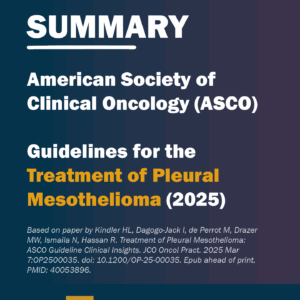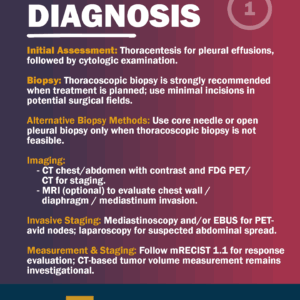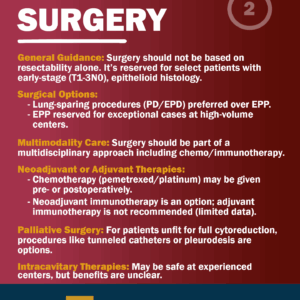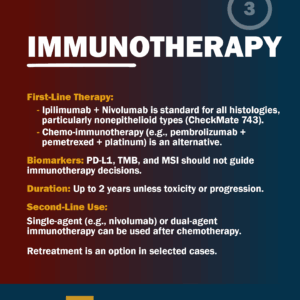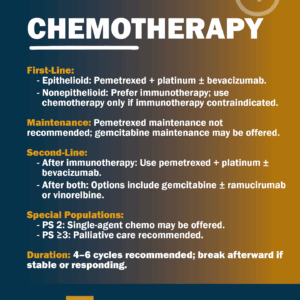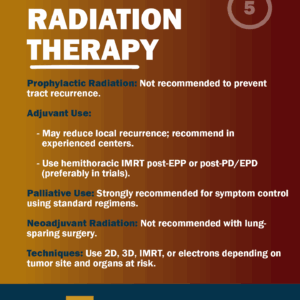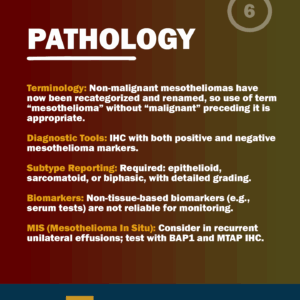Author: Maja Belamaric
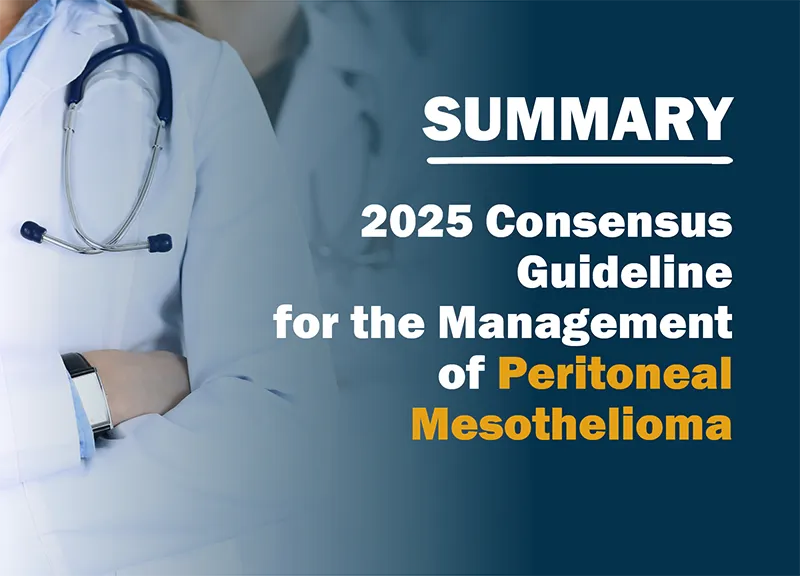
Summary of the 2025 consensus guideline for the management of peritoneal mesothelioma
It is estimated that approximately 3,000 people are diagnosed with mesothelioma each year in the United States. Compared with roughly 230,000 diagnoses of lung cancer, mesothelioma is a very rare cancer. Pleural mesothelioma, which is mesothelioma of the lining of the lung, is by far the most commonly occurring variety of this cancer. Peritoneal mesothelioma, which is mesothelioma that affects the lining of the abdominal cavity, sees 300-400 new diagnoses each year in the United States. For this reason, randomized clinical trials for peritoneal mesothelioma are not feasible. However, despite a lack of approved standard treatment for this type of mesothelioma, experts have come together to identify areas of consensus in what constitutes the best practices in treatment of peritoneal mesothelioma. This compilation of guidelines is an update on a previous iteration from 2018.
The manuscript by Brown LM, Wilkins SG, Bansal VV, Su DG, Gomez-Mayorga J, Turaga KK, Gunderson CG, Lee B, Nash GM, Hays JL, Raghav KP, Husain AL, Kluger MD, Zauderer MG, Kindler HL, Alexander HR; Peritoneal Surface Malignancies (PSM) Consortium Group. Consensus Guideline for the Management of Peritoneal Mesothelioma https://brand.msu.edu/Downloads. Ann Surg Oncol. 2025 Jun 25. doi: 10.1245/s10434-025-17358-x. Epub ahead of print. PMID: 40560500, was published in June of 2025.
The collection of these guidelines was made possible by ongoing research efforts, which include clinical trials. As the authors eloquently state:
“Clinical trial enrollment should be considered at every step of treatment, not only to expand our knowledge of this rare disease but also to enhance patient care opportunities.”
Major updates
- This iteration of treatment guidelines for peritoneal mesothelioma emphasizes the importance of a multi-disciplinary approach, particularly in a pre-operative setting.
- Additionally, psychosocial interventions should be incorporated as part of patient care throughout treatment and after.
- For benign pathologies such as peritoneal inclusion cysts and well-differentiated papillary mesothelial tumors, the new best practice is to observe while reserving surgical resection for patients with symptomatic, recurrent, diffuse, or microinvasive disease. Imaging surveillance type and specific treatment should be based on risk stratification.
2025 Consensus Guidelines for clinicians and patients navigating PeM diagnosis, treatment, and follow-up.
Diagnosis & Initial Assessment
-
Multidisciplinary Evaluation
- Engage surgical oncology, medical oncology, radiology, pathology, and social work.
-
Imaging
- CT or MRI of abdomen/pelvis with contrast.
- CT chest to check for spread.
- PET scan: optional in select cases.
-
Biopsy
- Prefer laparoscopic biopsy to assess tumor extent.
- Avoid cytology alone (often inadequate).
-
Pathology & Biomarkers
- Determine histologic subtype: epithelioid, biphasic, sarcomatoid.
- Test for Ki-67, PD-L1, ALK.
- Tumor somatic sequencing is not currently part of the protocol. Additional research is needed to determine clinical usefulness.
Benign or Borderline Disease
-
Asymptomatic, Localized Disease (e.g., WDPMT)
- Observation with imaging every 6 months.
-
Symptomatic or Progressive Disease
- Consider surgical resection.
- Repeat biopsy to rule out malignancy.
- Systemic therapy not routinely recommended.
Malignant Peritoneal Mesothelioma (PeM) Management
Risk Stratification:
- Low-Risk:
- Resectable disease.
- Favorable histology (epithelioid), younger age, good performance status.
- Treatment: Upfront CRS + IPCT.
- Intermediate-Risk:
- Larger tumor burden or borderline operability.
- Treatment: Neoadjuvant chemotherapy or immunotherapy, then reassess for surgery.
- High-Risk:
- Unresectable, poor performance status, aggressive histology.
- Treatment: Systemic therapy only (chemo or immunotherapy).
Systemic Therapy Options
- Epithelioid:
- First-Line: Pemetrexed + cisplatin/carboplatin ± bevacizumab OR nivolumab + ipilimumab.
- Second-Line: Switch to the other class (e.g., ICI if chemo first).
- Biphasic/Sarcomatoid:
- First-Line: Nivolumab + ipilimumab.
- Consider chemo if ICI is ineffective or not tolerated.
- Note: Clinical trial participation is encouraged at all stages.
Surgical Principles (CRS + IPCT)
- Goal: Complete cytoreduction (CC-0 or CC-1).
- May require resection of multiple abdominal organs.
- Requires expert surgical team.
- Consider palliative debulking in select cases.
Surveillance Protocol
- Benign Disease:
- CT/MRI every 6 months (first 2 years), then annually.
- Post-Treatment PeM:
- Every 3 months (years 1-2),
- Every 6 months (years 3-4),
- Annually thereafter.
Patient Support & Quality of Life
- Early referral to palliative care.
- Access to peer support and survivorship resources.
- Consider mental health and rehab services.
Conclusion
Management of PeM is highly individualized, requiring a multidisciplinary team and frequent reassessment. The consensus guideline promotes evidence-informed care and supports ongoing research to optimize treatment and survivorship outcomes.
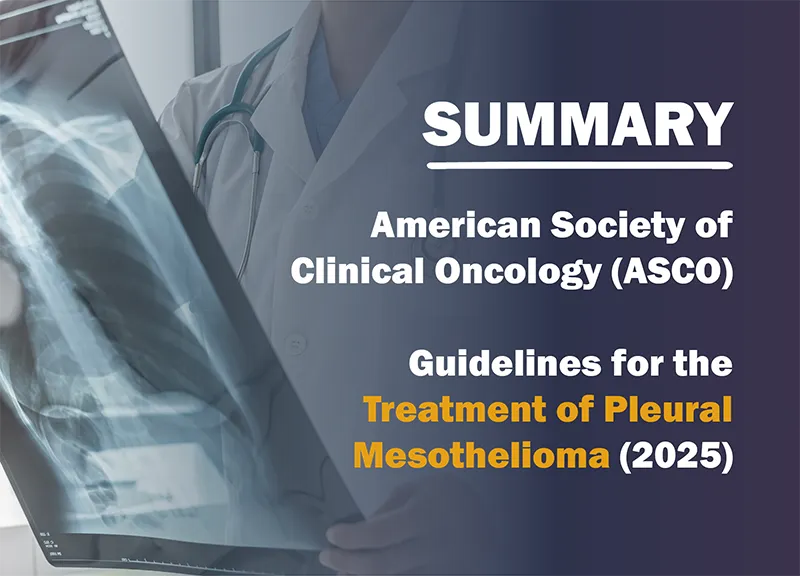
American Society of Clinical Oncology (ASCO) releases update to its pleural mesothelioma treatment guidelines
Earlier this year, the American Society of Clinical Oncology (ASCO) published an update to its 2018 guideline for the treatment of pleural mesothelioma. This summary of the guidelines is based on the published manuscript by Kindler HL, Dagogo-Jack I, de Perrot M, Drazer MW, Ismaila N, Hassan R. Treatment of Pleural Mesothelioma: ASCO Guideline Clinical Insights. JCO Oncol Pract. 2025 Mar 7:OP2500035. doi: 10.1200/OP-25-00035. Epub ahead of print. PMID: 40053896.
To update this document, mesothelioma experts from fields of medical oncology, surgery, pathology, radiation oncology and others, convened to review and analyze 110 relevant studies for each recommendation presented. The recommendations were divided into categories such as diagnosis, surgery, immunotherapy, chemotherapy, radiation therapy, pathology, and germline testing.
Researchers and providers who contributed to these treatment guidelines are affiliated with the following centers:
- University of Chicago Medicine
- American Society of Clinical Oncology
- University of California San Diego Moores Cancer Center
- Cross Cancer Institute, University of Alberta
- University of Wisconsin-Madison and Carbone Cancer Center
- Massachusetts General Hospital Cancer Center
- Johns Hopkins University
- Memorial Sloan Kettering Cancer Center
- Princess Margaret Cancer Centre – Toronto, Canada
- Center for Cancer Research, National Cancer Institute
- Levine Cancer Institute
- National Cancer Institute, Egypt
- Mesothelioma Applied Research Foundation
DIAGNOSIS AND STAGING
Mesothelioma patients often present with certain generalized symptoms that don’t go away after treatment. Pleural effusions, an uncomfortable accumulation of fluid in the pleural space that makes it difficult to expand the lung and breathe, are one of the most common symptoms.
Initial Assessment: In patients presenting with fluid, thoracentesis for pleural effusions, followed by cytologic examination is strongly recommended.
Biopsy: Thoracoscopic biopsy is strongly recommended when treatment is planned; use minimal incisions in potential surgical fields.
Alternative Biopsy Methods: Use core needle or open pleural biopsy only when thoracoscopic biopsy is not feasible.
Imaging:
- CT chest/abdomen with contrast and FDG PET/ CT for staging. (FDG is radioactive glucose injected into the bloodstream to see which areas of the tumor are metabolically active and how active they are.
- MRI (optional) to evaluate chest wall / diaphragm / mediastinum invasion.
Invasive Staging: Mediastinoscopy and/or EBUS for PET-avid nodes in candidates for maximal surgical cytoreduction; laparoscopy for suspected abdominal spread.
Measurement & Staging:
- Expert radiologist should perform measurements on CT scan based on modified RECIST 1.1 criteria.
- Follow mRECIST 1.1 for response evaluation; CT-based tumor volume measurement remains investigational.
SURGERY
Mesothelioma surgery has been at the center of debate since the release of the United Kingdom’s phase III study results from the Mesothelioma and Radical Surgery (MARS) 2 randomized controlled clinical trial. This was the first such trial in mesothelioma. The study results showed that patients treated with chemotherapy alone fared better than those who underwent surgery. However, researchers caution that interpretation of the study ought to consider data from nonrandomized surgical studies which show better outcome and much lower 30 and 90-day mortality. As a result, surgery should still be considered for patients with favorable prognostic characteristics.
General Guidance: Surgery should not be based on resectability alone. It’s reserved for select patients with early-stage (T1-3N0), epithelioid histology.
Surgical Options:
- Lung-sparing procedures (PD/EPD) preferred over EPP.
- EPP reserved for exceptional cases at high-volume centers.
Multimodality Care: Surgery should be part of a multidisciplinary approach including chemo/immunotherapy.
Neoadjuvant or Adjuvant Therapies:
- Chemotherapy (pemetrexed/platinum) may be given pre- or postoperatively.
- Neoadjuvant immunotherapy is an option; adjuvant immunotherapy is not recommended due to limited data currently available.
Palliative Surgery: For patients unfit for full cytoreduction, procedures like tunneled catheters or pleurodesis are options.
Intracavitary Therapies: May be safe at experienced centers, but benefits are unclear.
IMMUNOTHERAPY
First-Line Therapy:
- Ipilimumab + Nivolumab is standard for all histologies, particularly nonepithelioid types (CheckMate 743).
- Chemo-immunotherapy (e.g., pembrolizumab + pemetrexed + platinum) is an alternative.
Biomarkers: PD-L1, TMB, and MSI should not guide immunotherapy decisions.
Duration: Up to 2 years unless toxicity or progression.
Second-Line Use:
- Single-agent (e.g., nivolumab) or dual-agent immunotherapy can be used after chemotherapy.
- Retreatment is an option in selected cases.
CHEMOTHERAPY
Chemotherapy was for many years the only standard treatment approved for mesothelioma. This treatment regimen is most familiar to researchers and physicians alike ensuring the most consistent side effect control. However, chemotherapy for mesothelioma has many limitations. For instance, patients with the nonepithelioid subtype do not respond to chemotherapy very well.
First-Line:
- Epithelioid: Pemetrexed + platinum ± bevacizumab.
- Nonepithelioid: Prefer immunotherapy; use chemotherapy only if immunotherapy is contraindicated.
Maintenance: Pemetrexed maintenance not recommended; gemcitabine maintenance may be offered.
Second-Line:
- After immunotherapy: Use pemetrexed + platinum ± bevacizumab.
- After both: Options include gemcitabine ± ramucirumab or vinorelbine.
Special Populations:
- PS 2: Single-agent chemo may be offered.
- PS ≥3: Palliative care recommended.
Duration: 4–6 cycles recommended; break afterward if stable or responding.
RADIATION THERAPY
Radiation therapy for mesothelioma is typically used in conjunction with other treatments to reduce chances of local recurrence. Sometimes, it is also used to shrink tumors as symptom-management.
Prophylactic Radiation: Not recommended to prevent tract recurrence.
Adjuvant Use:
- May reduce local recurrence; recommend in experienced centers.
- Use hemithoracic IMRT post-EPP or post-PD/EPD (preferably in trials).
Palliative Use: Strongly recommended for symptom control using standard regimens.
Neoadjuvant Radiation: Due to potential for severe pulmonary toxicity, neoadjuvant radiation is not recommended with lung-sparing surgery.
Techniques: Use 2D, 3D, IMRT, or electrons depending on tumor site and organs at risk.
PATHOLOGY
The field of pathology is crucial in diagnosing the exact type of tumor in order to help determine the appropriate treatment.
Terminology: Non-malignant mesotheliomas have now been recategorized and renamed, so use of term “mesothelioma” without “malignant” preceding it, is now appropriate.
Diagnostic Tools: IHC with both positive and negative mesothelioma markers.
Subtype Reporting: Required: epithelioid, sarcomatoid, or biphasic, with detailed grading.
Biomarkers: Non-tissue-based biomarkers (e.g., serum tests) are not reliable for monitoring.
MIS (Mesothelioma In Situ): Consider in recurrent unilateral effusions; test with BAP1 and MTAP IHC.

Parp-Inhibitors show promise in mesothelioma treatment
At this year’s American Association for Cancer Research, investigators from the United Kingdom announced the positive results of a mesothelioma clinical trial testing a relatively new class of targeted drugs: the PARP inhibitors.
The study Niraparib Efficacy in Patients With Unresectable Mesothelioma (NERO) enrolled 88 patients randomized into two groups showed that those treated with niraparib extended the median progression-free survival by 1.5 months compared to the arm of patients who only received symptom management care.
Eligible patients had already undergone standard chemotherapy treatment for mesothelioma with success, but they relapsed with the cancer coming back or growing.
Currently, there are no proven therapies for mesothelioma beyond initial treatment and after recurrence. Data on the efficacy of chemotherapy are limited, and immunotherapy retreatment has been only a recent addition to the doctors’ treatment arsenal.
What are PARP inhibitors?
Simply put, PARP inhibitors are drugs that prevent the enzyme known as poly ADP ribose polymerase (PARP) from doing its job of repairing damaged DNA in cells. If not repaired, damaged cells, including cancer cells, die. Conversely, if repaired, even if the repair is erroneous, the cells go on to survive and replicate which can be problematic with cancerous cells. Typically, patients who responded to chemotherapy previously are more likely to see a benefit from this class of drugs. While this study did not require patients enrolled to have a somatic BAP1 deletion, other studies looking into this agent often do. Somatic mutations are those not passed down to offspring and are instead acquired in the cells over time. BAP1 is a tumor suppressor gene, therefore its deletion is understood as consequential in mesothelioma.
Clinical trials employing PARP inhibitors currently available in the United States
While this study took place in the United Kingdom, in the U.S. clinical studies utilizing PARP inhibitors have been available to mesothelioma patients who fit certain eligibility criteria. Currently, one of those studies is still open and enrolling.
Olaparib in Patients with HRD Malignant Mesothelioma is available at the University of Chicago Medicine to patients with the loss of BAP1 and/or a germline (passed down from parents) or somatic (acquired over lifetime) mutation that disrupts protein function in at least one of the patient’s genes.

Could there be another mesothelioma cell type beyond epithelioid, sarcomatoid, and biphasic?
In recent years, mesothelioma histology has become more important than ever, as researchers find that certain treatments are more effective against different cell types. The epitheliod subtype of mesothelioma is by far the most common and is considered the least aggressive of the three types. The sarcomatoid subtype is less common but most aggressive. When a tumor contains both types of cells, it is known as biphasic.
As far as treatment goes, epitheliod mesothelioma tends to respond to chemotherapy better than the sarcomatoid subtype, while benefits of immunotherapy are more pronounced in patients with the more aggressive sarcomatoid subtype.
But now, researchers believe to have identified mesothelioma cells that are neither sarcomatoid nor epitheliod. In the preprint article “Comprehensive multi-site profiling of the malignant pleural mesothelioma micro-environment identifies candidate molecular determinants of histopathologic type,” by Raphael Bueno, MD, et al., the authors suggest that a third category of cells exist in the tumor microenvironment of mesothelioma and are most prevalent in tumors of patients with biphasic disease. Those cells have been named “uncommitted” because the idea is that at some point they might take on an epitheliod or sarcomatoid appearance.
As the researchers examined tumor samples, they noticed that in predominantly epitheliod, and in predominantly sarcomatoid mesotheliomas, such uncommitted cells were few, but in biphasic mesothelioma they were substantial.
Significance of histology (tumor cell type) for mesothelioma patients
The cellular type of the mesothelioma tumor helps doctors determine the prognosis and best treatment for a patient. For example, it is currently known that survival varies depending on the cell type. Patients with epitheliod mesothelioma have the best prognosis, and those with sarcomatoid the worst. The biphasic patients tend to fall in between depending on the proportion of epitheliod vs sarcomatoid cells in their tumors. Moreover, tumor histology helps doctors identify the best treatment for a patient. Sarcomatoid and biphasic tumors have shown the greatest benefit when treated with immunotherapy, and the least benefit when treated with chemotherapy. As mesothelioma research continues to advance, the tumor microenvironment is seen as far more important than individual cells in the proliferation of this cancer.
Because mesothelioma prognosis currently relies so heavily on histology, this discovery adds another layer of nuance to an already complex disease. In addition to understanding the significance and purpose of these uncommitted cells, another question for researchers to untangle in the future will be to understand whether these uncommitted cells ultimately become committed, and whether they commit to the epitheliod or sarcomatoid type and why.
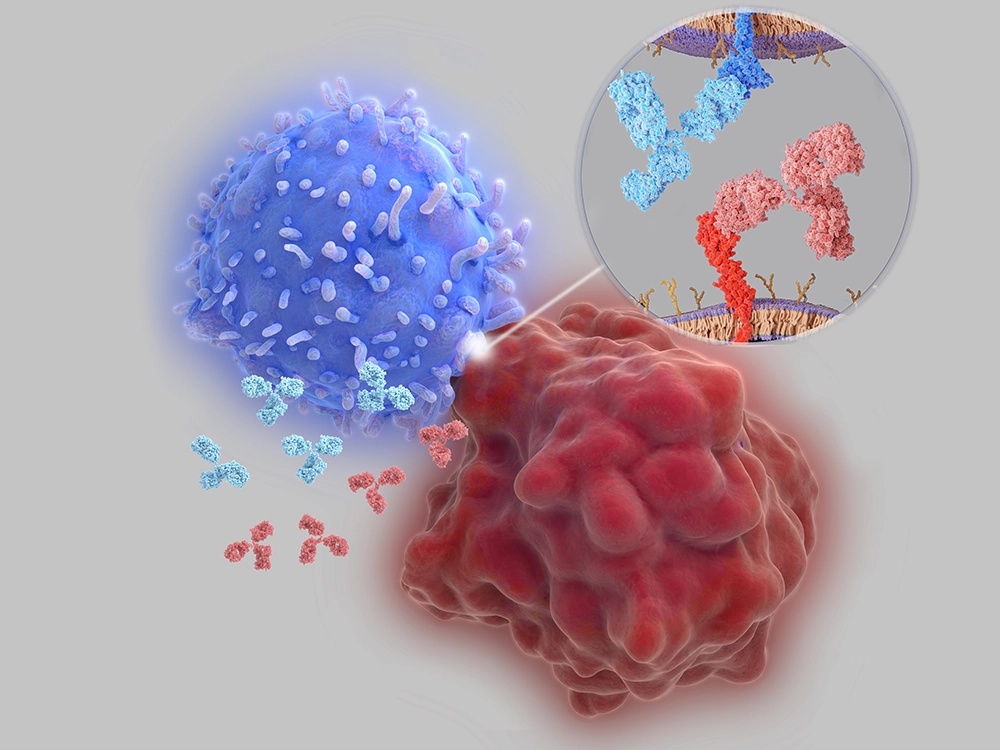
Predicting effectiveness of mesothelioma immunotherapy
In recent years, immunotherapy has revolutionized cancer treatment for most cancers, and even the notably difficult-to-treat mesothelioma has reaped benefits. However, despite two new FDA treatment approvals featuring immunotherapy, this treatment only works for a minority of mesothelioma patients and the benefit is most obvious in the most aggressive, sarcomatoid group. This fact, paired with concerns of immune toxicity, can make some patients and physicians wish they had more tools to gauge if immunotherapy will be more useful than harmful. But are we able to predict its effectiveness before starting treatment?
Drs. Farhad Kosari and Maria Disselhorst of the Mayo Clinic, among others, have been studying exactly this problem. In their paper “Tumor Junction Burden and Antigen Presentation as Predictors of Survival in Mesothelioma Treated with Immune Checkpoint Inhibitors” published in the Journal of Thoracic Oncology, the authors conclude that an analysis of tumor genetics for mutations may facilitate patient selection for immunotherapy treatments based on checkpoint inhibitors.
Why is mesothelioma so difficult to treat?
There are many reasons for mesothelioma’s resistance to treatment. When it comes to the immune system’s role in this cancer’s proliferation, patients may hear researchers discuss its “low mutation burden.” What this means is that the cancer cells don’t look that different from the body’s non-cancerous cells on a genetic level. In other words, the number of gene mutations in a mesothelioma tumor are so few that the tumor looks like a normal cell to the immune system, which is in part how it evades it.
Based on scientific studies, the tumor mutation burden generally predicts the effectiveness of the immune checkpoint inhibitor therapy used for other cancers. The more mutations there are on the tumor that differentiate it from normal tissue, the easier it is for the primed immune system to see it and attack it, and the easier it is to target the tumor with therapies.
The flipside of this, of course, is that with mesothelioma that’s not the case, which begs the question: why do some mesothelioma patients respond to immunotherapy, while others don’t? What is so different about the ones who respond?
Tumor junction burden and antigen presentation as predictors of survival in mesothelioma
Researchers looked at 68 patients who had been treated with nivolumab and ipilimumab and nivolumab alone. Of these patients, 44 had sufficient DNA and RNA content derived from biopsy to be part of this analysis. What they concluded is that patients with a high tumor junction burden and antigen presentation survived longer than those without suggesting that it may be possible to use this information to select which patients might benefit from immunotherapy.
As mesothelioma treatment continues to head in the direction of targeted therapies, the expectation is that molecular and genetic knowledge acquired over the last decade will be incorporated into new generation treatment paradigms so doctors and patients can make fully informed decisions about treatment based on each individual patient’s circumstances.
Free Mesothelioma Patient & Treatment Guide
We’d like to offer you our in-depth guide, “A Patient’s Guide to Mesothelioma,” absolutely free of charge.
It contains a wealth of information and resources to help you better understand the condition, choose (and afford) appropriate treatment, and exercise your legal right to compensation.
Download Now